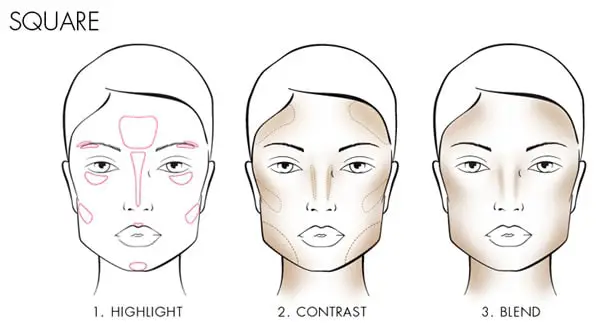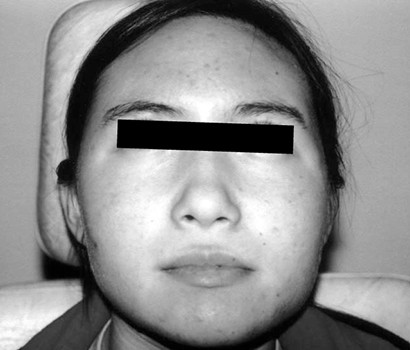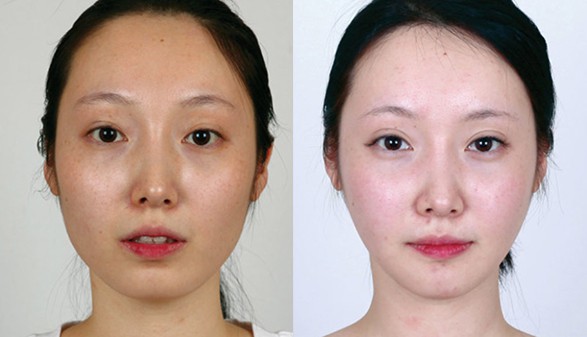
A square jaw can be an attractive feature, but an overly aggressive square jawline can be distracting. While guys can get away with overly large jaws, most females might want to fix theirs.
You can reduce a square jaw naturally by trying out contour, wearing a nightguard, and stop chewing gum or other hard foods. However, it also depends on whether you have big jaw muscles or a prominent mandible. People with big mandibles may need surgery to reduce their jaw, and Botox can reduce large jaw muscles.
How to Naturally Reduce a Square Jaw
Contour

Makeup is an effective way to soften a square jaw temporarily. Contouring is a makeup technique that sculpts, defines, and enhances your face. When you contour, you add “shadows” and depth to your face. You can use it to make your jaw look slimmer.
Firstly, you should pick a contour color that is slightly darker than your natural skin tone. Try to avoid shades that are several shades darker than your skin tone. You want your contour to look natural.
Apply the contour in a scooping motion below your cheekbone, bringing it down to your jawline. Apply the contour along your jawline in a rounded motion; avoid creating chiseled lines. Make sure you blend the edges of the contour very well to create a softer finish.
Whether you use cream or powder contour, it is always good to remember that less is more. Start applying your contour little by little and blending it. You can always add a little more as needed. Applying too much contour at one time can look too harsh or muddy when you try to blend it.
You can also use contour highlighting to your advantage. Highlighter does the opposite of contour. It brightens specific parts of your face to draw more attention to those areas.
You can bring less attention to your jawline with highlighting. You can add some highlighter to the center of your forehead, top of your cheekbones, philtrum, the bridge and tip of your nose, and your chin.

Wear a Night Guard
If you have TMJ symptoms like grinding your teeth, a nightguard can come in handy. TMJ symptoms like bruxism (teeth grinding) makes you unconsciously grind and clench your teeth. Your jaw muscles tighten and get a workout, which means your jaw muscles will grow larger and emphasize your jawline.
While people can unknowingly grind their teeth while they are awake, some people have sleep bruxism. They clench, gnash, and grind their teeth while they sleep. It can be challenging to stop yourself when you are sleep.
Luckily, wearing a nightguard can help you. Nightguards look like mouth guards that athletes in sports like rugby and boxing wear.
You can wear it at night, so pressure gets evenly applied to your teeth. It can also reduce grinding noises.
You can buy a night guard in a pharmacy or online. You will need to boil most of them and fit it into your mouth, so the night guard molds around your teeth to fit well.
However, getting a night guard from a dentist or doctor may be better. They are custom made specifically for your teeth and needs, so they often feel and work better than ones you can buy at a store.

Minimize or Stop Chewing Gum
Some people try to chew gum to try to define or tone their jawline. However, you should minimize or stop chewing gum if you want to reduce a square jaw, along with hard foods that might be in your diet or require a lot of chewing.
Your masseter muscles are like any other muscle. The more you use them, the larger they will grow. Therefore, chewing gum regularly would be very counterproductive if you want a smaller jaw.
However, this does not mean you have to transition to a liquid diet. Chewing food as you usually would will not dramatically increase the size of your jaw muscles.
Therefore, you will not have to worry about getting a huge jaw just from eating. You can choose softer foods if you want to decrease how often you chew.
Botox

Botox can partially relax the masseter muscles. While it is not technically “natural,” other than being a natural poison, Botox can help you out a lot. It helps the masseter muscles relax, causing them to slowly decrease in size to create a slimmer, less square jawline.
How many injections you will get will depend on your doctor’s judgment. Some people get three injections per side, but some people will require more or fewer injections per side. How many injections you need will also determine how long the procedure will last. Most doctors can complete the procedure within 10-30 minutes.
However, it is essential to remember that this will gradually slim your jawline. Your jaw muscles will not immediately shrink from Botox injections. Most people will see a difference in their jawline after three weeks.
Keep in mind that your results will not last forever. Most people need to get Botox injections every 3-6 months to retain a slim jaw. This is why you should cure any teeth grinding or other oral issues you have first.
Additionally, Botox can be a helpful way to treat TMD (Mor et al., 2015). Forty-six patients with TMD reported significant decreases in pain. It can treat other symptoms, including bruxism, masseter hypertrophy, and headaches.
Some people have more extreme cases of TMJ. Botox can also minimize lockjaw since it helps the masseter muscles relax. Most people notice a decrease in their TMJ symptoms two weeks after getting Botox injections.
How to Reduce a Large Mandible
Most of the tips mentioned above address square jaws caused by large masseter muscles. However, it may not be beneficial for people who have large, square mandibles.
You cannot naturally shrink your jawbone. The jawbone naturally decreases with age, but you will not notice a significant change in your jawline until you are in your late 50s-60s.
Therefore, people with square mandibles may need more invasive procedures to reduce a square jaw.
V-Line Surgery
V-line surgery is a major surgery that augments your chin and jawline to make it look narrower and contoured. As you can guess from the name, the surgery helps you get a V-shaped jaw.
To perform the procedure, a surgeon will create incisions on your chin and along your jawline. Your surgeon will carve your jaw to be at a sharper angle through those incisions. They will shave down your jawline to help make it thinner.

In some cases, people will also get a chin implant. A chin implant can help emphasize the V-shape. However, it is not always necessary, especially if you have a relatively small chin. Additionally, a surgeon may already shave your chin to sharpen it during a V-line surgery. Therefore, you may not need a chin implant if shaving the chin bone was enough.
Your surgeon will stitch the incisions together once the surgery is complete. They might insert temporary drains to help your face heal. The surgery typically takes 1-2 hours to complete.
You will likely have to stay in the hospital overnight. The doctors and nurses will monitor you to make sure there were no complications. If there is nothing wrong, you can go home to complete your recovery.
You may experience some side effects for a few weeks. Some common side effects include:
- Headache (usually after general anesthesia)
- Facial bruising
- Pain
- Facial swelling and inflammation
- Nerve damage (for example, numb lips)
Uncommon side effects include:
- Black, yellow, or green drainage from the wound
- Nausea
- Fever
- Dizziness
If you have any of the uncommon side effects, you should see your doctor immediately.
The common side effects can last for 1-2 weeks. You will have to wait until you fully recover to see your new jawline. Most people make a full recovery in 3-4 weeks.

